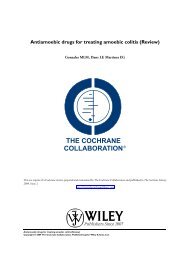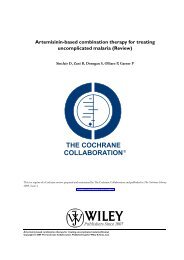Interventions for treating proximal humeral fractures in adults (Review)
Interventions for treating proximal humeral fractures in adults (Review)
Interventions for treating proximal humeral fractures in adults (Review)
Create successful ePaper yourself
Turn your PDF publications into a flip-book with our unique Google optimized e-Paper software.
[Intervention <strong>Review</strong>]<br />
<strong>Interventions</strong> <strong>for</strong> <strong>treat<strong>in</strong>g</strong> <strong>proximal</strong> <strong>humeral</strong> <strong>fractures</strong> <strong>in</strong><br />
<strong>adults</strong><br />
Helen HG Handoll 1 , Rajan Madhok 2<br />
1 Centre <strong>for</strong> Rehabilitation Sciences (CRS), Research Institute <strong>for</strong> Health Sciences and Social Care, University of Teesside, Middlesborough,<br />
UK. 2 Cochrane Bone, Jo<strong>in</strong>t and Muscle Trauma Group, University of Manchester, Manchester, UK<br />
Contact address: Helen HG Handoll, Centre <strong>for</strong> Rehabilitation Sciences (CRS), Research Institute <strong>for</strong> Health Sciences and Social<br />
Care, University of Teesside, School of Health and Social Care, Middlesborough, Tees Valley, TS1 3BA, UK. h.handoll@tees.ac.uk.<br />
H.Handoll@ed.ac.uk.<br />
Editorial group: Cochrane Bone, Jo<strong>in</strong>t and Muscle Trauma Group.<br />
Publication status and date: Edited (no change to conclusions), published <strong>in</strong> Issue 4, 2008.<br />
<strong>Review</strong> content assessed as up-to-date: 28 September 2006.<br />
Citation: Handoll HHG, Madhok R. <strong>Interventions</strong> <strong>for</strong> <strong>treat<strong>in</strong>g</strong> <strong>proximal</strong> <strong>humeral</strong> <strong>fractures</strong> <strong>in</strong> <strong>adults</strong>. Cochrane Database of Systematic<br />
<strong>Review</strong>s 2003, Issue 4. Art. No.: CD000434. DOI: 10.1002/14651858.CD000434.<br />
Copyright © 2008 The Cochrane Collaboration. Published by John Wiley & Sons, Ltd.<br />
Background<br />
A B S T R A C T<br />
Proximal <strong>humeral</strong> <strong>fractures</strong> are common. The management, <strong>in</strong>clud<strong>in</strong>g surgical <strong>in</strong>tervention, of these <strong>in</strong>juries varies widely.<br />
Objectives<br />
To review the evidence support<strong>in</strong>g the various <strong>in</strong>terventions <strong>for</strong> <strong>treat<strong>in</strong>g</strong> <strong>proximal</strong> <strong>humeral</strong> <strong>fractures</strong>.<br />
Search strategy<br />
We searched the Cochrane Bone, Jo<strong>in</strong>t and Muscle Trauma Group Specialised Register (September 2006), the Cochrane Central<br />
Register of Controlled Trials, MEDLINE, EMBASE and other databases, and bibliographies of trial reports. The search ended <strong>in</strong><br />
September 2006.<br />
Selection criteria<br />
All randomised controlled trials pert<strong>in</strong>ent to the management of <strong>proximal</strong> <strong>humeral</strong> <strong>fractures</strong> were selected.<br />
Data collection and analysis<br />
Two people per<strong>for</strong>med <strong>in</strong>dependent quality assessment and data extraction. Trial heterogeneity prevented meta-analysis.<br />
Ma<strong>in</strong> results<br />
Twelve small randomised trials with 578 participants were <strong>in</strong>cluded. Bias <strong>in</strong> these trials could not be ruled out.<br />
Seven trials evaluated conservative treatment. There was very limited evidence that the type of bandage used had any <strong>in</strong>fluence on the<br />
time to fracture union and the functional end result. However, an arm sl<strong>in</strong>g was generally more com<strong>for</strong>table than a body bandage.<br />
There was some evidence that ’immediate’ physiotherapy compared with that delayed until after three weeks immobilisation resulted<br />
<strong>in</strong> less pa<strong>in</strong> and faster and potentially better recovery <strong>in</strong> people with undisplaced two-part <strong>fractures</strong>. Similarly, there was evidence<br />
that mobilisation at one week <strong>in</strong>stead of three weeks alleviated short term pa<strong>in</strong> without compromis<strong>in</strong>g long term outcome. Two trials<br />
provided some evidence that unsupervised patients could generally achieve a satisfactory outcome when given sufficient <strong>in</strong>struction to<br />
pursue an adequate physiotherapy programme.<br />
<strong>Interventions</strong> <strong>for</strong> <strong>treat<strong>in</strong>g</strong> <strong>proximal</strong> <strong>humeral</strong> <strong>fractures</strong> <strong>in</strong> <strong>adults</strong> (<strong>Review</strong>)<br />
Copyright © 2008 The Cochrane Collaboration. Published by John Wiley & Sons, Ltd.<br />
1








